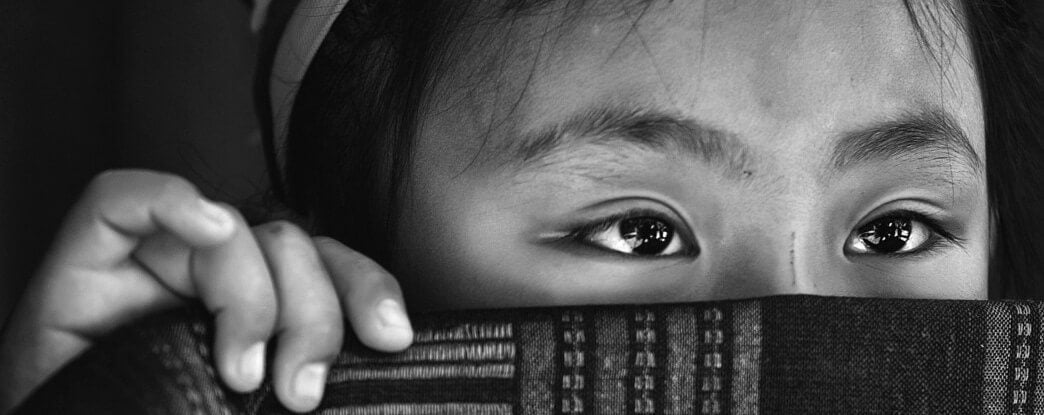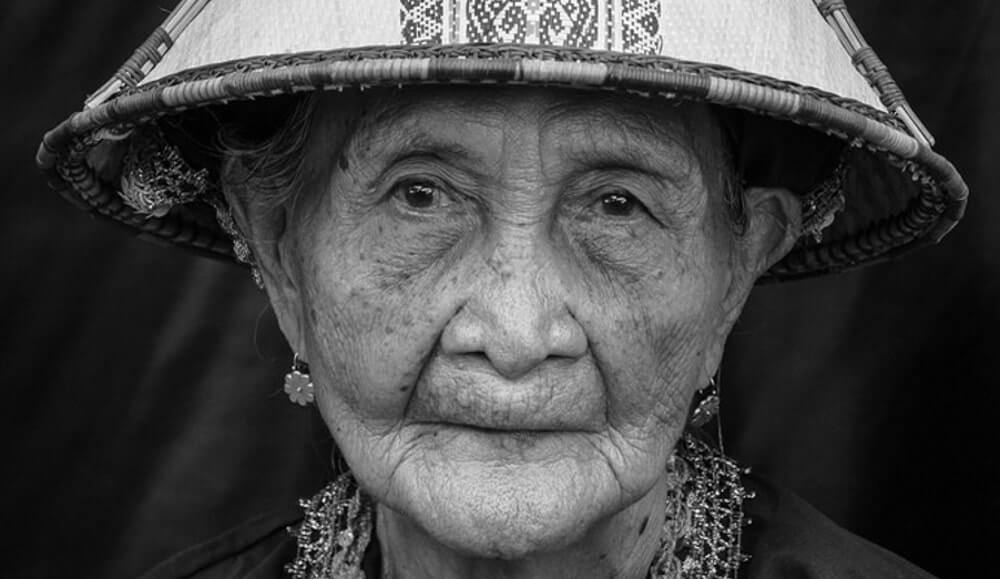Myths, History and Folklore of RICE in Thailand. It is believed that the gods or goddesses gave rice to humans and taught them how to grow rice. Religious use of rice takes place in Thailand, India, China, Indonesia, Sri Lanka and Malaysia.
In Asia, the rice spirit is female and often a mother figure. In Thailand, the Rice Goddess is Mae Posop or Mae Phosop. Mae Posop and the Rice Goddess, Devi Sri, are treated in similar ways- respectful and protective.
In this Article
Myths, History and Folklore of RICE in Thailand
Kin Khao Ma Rue Yang?
“Have you eaten yet?” is one of the common ways for people to greet each other in Thai culture.
Eating Rice in Thailand
Traditionally, the first thing women did in the early morning was to cook rice.
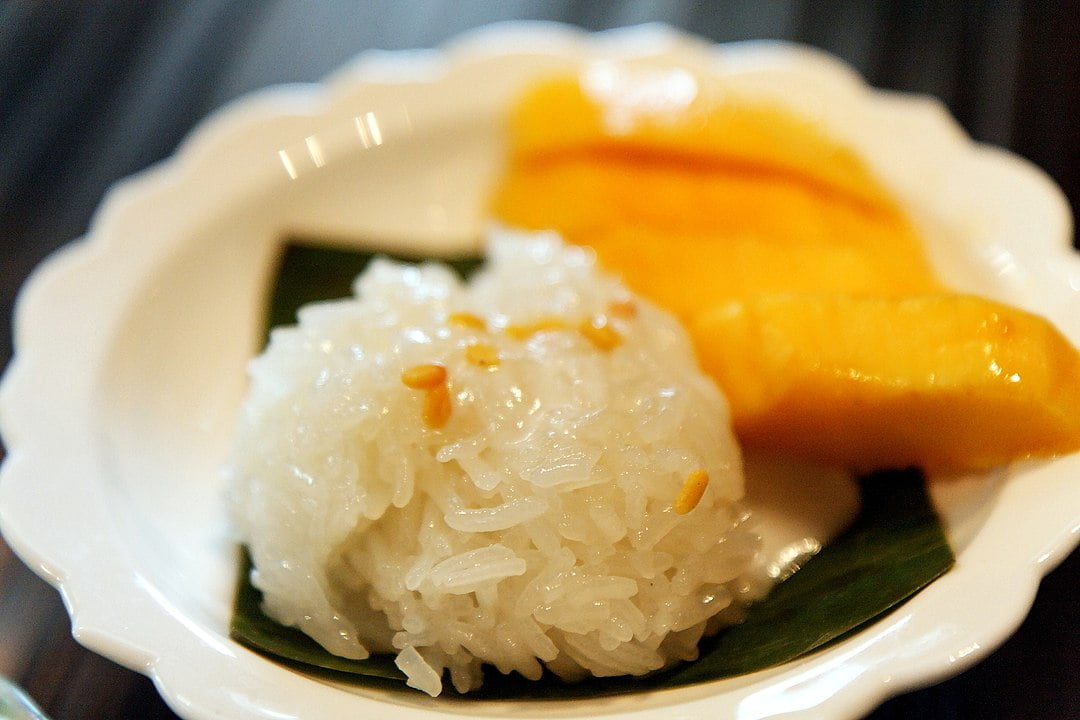
We love Mango sticky rice. Bangkok , Thailand
Then, before anybody could eat any, the spirit of the land or the ancestor shrine would get a rice offer first. Also monks who go alms- round, will get rice. Thai people believe that this offering to the monks benefits the families as well as all other beings.
Thai fragrant Jasmine Rice
Thai Hom Mali Rice, popularly known as “jasmine rice,” is an original species developed by a local Thai farmer and improved to be a premium white rice with pandan- like aroma, globally known for its quality, long grain, curled-up tips, and clear, glossy exterior. When cooked, the rice maintains its white color and long grain, although the texture becomes tender, fragranced with a fresh, appetizing aroma that goes well with almost all savory dishes.
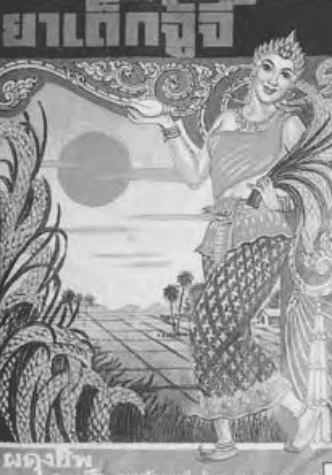
In Thailand, khao tom (a soft soupy rice gruel) is served as breakfast with other dishes, but the most popular rice dishes include garlic rice, saffron rice, rice colored with coconut milk, and fried rice with meat and tomato ketchup or fish paste.
Rice is also consumed as rice balls, rice cakes, rice pudding, and rice noodles. All eaten from flat plates with spoons, and forks.
Local people, used to tell their children while taking their meals of rice and condiments to give special consideration to the rice as an act of respect to Mae Posop โพสพ or Mae Khosok, the Rice Mother. When raising the hand to place a spoon full of rice into the mouth, a person must be careful not to let any rice fall on the floor as such an act is deemed bad manners.
Moreover, to step over any grain of boiled rice that has fallen on the floor or on the ground is bad manners. At the end of the meals, young children are taught to thank the Rice Mother with a ‘wai’ (the Thai gesture of respect made by raising the two hands joined together).
To celebrate the Lunar New Year in Thailand, sticky rice cakes are prepared with mortar and pestle and cooked in the fire until a golden brown color is obtained. Khao Chae in Thailand also originated from the celebration of the first day in the lunar calendar when the Mon people offered Kao Songkran (Songkran rice), later Khao Chae modified with ease to be soaked (chae) in water, to the female guardian spirit of the New Year.
Khao, or rice is not only a staple food or just a grain, but it is believed to possess sacred spirit. This spirit is called Rice Mother.
THE RICE MOTHER- MAE POSOP โพสพ
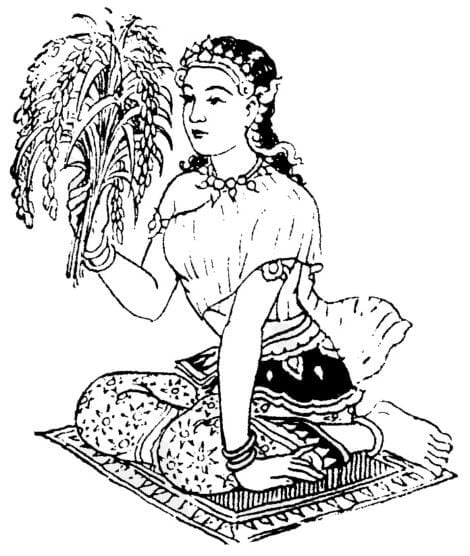
In Thailand, the rice goddess or rice mother is Mae Posop โพสพ or Phaisop ไพสพ, she is worshiped and believed to bring good harvest. Therefore, no men, loud noises, or talk of death or demons are permitted before harvest since Mae Posop is shy and easily frightened; miscarriage of her pregnancy during harvest time might occur.
Normally, she is presented in the figure of a long-haired Thai woman wearing a Thai-style frontlet and shawl, sitting on the floor with legs tucked back and holding a full ear of rice in her right hand.
Taboos concerning the Rice Goddess:
- The Rice Goddess exists and is visible, some people can see her but they shall never touch her.
- People should not criticize or condemn the Rice Goddess otherwise they will not have prosperity in life.
- One should not make pipes from rice stubble left after the harvest because this action will frighten the Rice Goddess.
- One should not dig a canal or make a new road in an area where rice is grown because one will not have prosperity in life.
Many rice growers have statues or pictures of the Rice Goddess to worship, in some families, people place the ears of rice on their shelves instead of on the statues and pictures. Some put the ears orifice in a plastic bag or bowl and leave it on a shelf with an image of the Buddha. Others arrange ears of rice in the shape of a nicely dressed woman and place it on a shelf with a Buddha image.
MYTHS OF THE RICE MOTHER

Based on oral tradition, various myths demonstrate the unique beliefs that each group holds and reflect the goddess veneration in Thailand. In their myths, each community calls the Rice Mother by a different name such as Ya Kwan Khao – Grandmother Spirit of Rice, Lady Kwan Khao – Spirit Essence of Rice, Nang Phrakosob, or Mae Posop – The Rice Mother. She is also known as Mae Khwan Khao “Mother of Rice Prosperity”. Even in the same village, each person tells a unique story. Old myths have been found written on palm leaves in rice cultivation texts. Myths of the Rice Mother from various groups of people are discussed in the work from Pairin Jotisakulratana, most of the myths come from her interviews with farmers in several regions of the country. People learned about the Rice Mother myths, trough storytelling – from their elders and from participating in rituals in which stories of the Rice Mother are recited.
CENTRAL MYTHS
The first myth shows signs of Hinduism, the goddess is dependent on men. On the other hand, the other myth strongly rejects violence against women and rejects the role of men in rituals to the Rice Mother.
The Rice Mother and the Hermit
Mae Posop used to be a goddess named Po Sawa Devi, a mistress of Lord Indra. Her duty was to pick flowers and make offerings to Indra. At the end of her life, she vowed to reincarnate to help human beings. She became a plant growing in front of a hermit‘s hut. The hermit saw the plant and realized that he had never seen that kind of plant before. He beat it and it transformed to be Po Sawa Devi. The goddess informed the hermit that she reincarnated from heaven to help human beings. Helping Po Sawa Devi fulfilling her wish, the hermit threw the plant to the sky. The plant was transformed into rice and was spread in every direction.
The Rice Mother is Sexually Harassed by a Man
In the past, men could perform rituals to Mae Posop.
One day a man called the spirit essence of rice to the rice barn. He laid eyes on the beautiful Mae Posop and sexually harassed her. The Rice Mother then fled. Since then, men are not allowed to perform this ritual to the Rice Mother.
NORTH- EASTERN MYTH
This myth written on palm leaves was found in a temple in northeastern by anthropologist S. J. Tambiah. The old themes are seen in the myth: rice was big in size and then diminished. The widow is portrayed as an old woman with great merits. Rice is portrayed as a life-giver with the power to bring death. This myth demonstrates two approaches to the Rice Mother.
- The first one brings death. If people treat rice without respect, rice flees.
- The second situation brings life back.
The young man and the old couple were humble to the Rice Mother, so natural elements, such as the bird, fish, deer, and the ruler of the kingdom, helped bring the Rice Mother back.
The Rice Mother and the Five Buddhas

In the time of Phraya Wirupakha, a world guardian deity, rice grew by itself and its grain was five times the size of the human fist and it had the fragrance of coconut and cow‘s milk. Human beings cut the rice, cooked, and ate it. In this way life was sustained. Ever since then, rice has been the food of humans.
Phraa Chao Kakusantho, the first Buddha, brought rice with him to feed humans and religion. Later in the era of Phraa Gonag no, the second Buddha, rice grain became smaller-four times that of the human fist. The rice preserved its fragrance and people did not starve.
At this time there lived an old widow who had been married seven times. She decided to build a barn. While it was being built her merit caused rice to grow by itself under her barn.
She was annoyed by the profusion of growth and hit the rice grains with a stick. The grains scattered.
The big pieces fell in the jungle and this became mountainous rice.
Other pieces fell into water and grew there. This rice was called Nang Phrakosob. Rice was angry with people and did not return to them. People starved for 1,000 years.
A son of a rich man was lost in a forest. During his wanderings, he came to a swamp. Since he could not go any farther, he sat down and cried. A fish heard him and addressed him with sweet and gentle words. It told him that it would bring Nang Phrakosob to him, and that if anyone eats her, the person would be cured from sickness. She lived in a cave in the forest, and the animals in the forest paid homage to her because she was virtuous.
The young man went to the cave where she lived. On his approach, she flew to meet him, and he caught her by the leg. He tried to persuade her to return to the world of human but she refused.
Now there were two angels who sympathized with the fish‘s plan. One changed himself into a golden deer, the other into a parrot. They tried to persuade Nang Phrakosob with sweet words to go back to sustain life and religion; the Buddha would be reborn and she would be praised more than ever.
Finally, she agreed to accompany the young man to town and sustain life and religion.
During the era of Phraa Chao Kassapo, the third Buddha, rice grains had diminished in size again. It remained fragrant as before, and the Buddha lived on rice. During the time of Phraa Chao Sakkyamuni Godhom, the fourth Buddha, rice grain had grown smaller, one and a half times the size of the human fist.
One thousand years later, there lived a man of high rank whose heart was filled with jealousy and who never made any meritorious acts. He ordered his men to build a barn to store rice in and he sold the rice. Nang Phrakosob felt humiliated that she was being sold.
So she took flight to a mountain. As a result, people died of starvation and this continued for 320 years.
An old couple suffered from hunger. They tried hard to clear the land in search of rice but it was in vain. An angel helped the couple find Nang Phrakosob who was staying with Chao Rathi, the ruler of the kingdom. Chao Rathi asked Nang Phrakosob to go back with the couple to feed lives and religion. However, she refused for fear of being beaten and sold. Chao Rathi then gave the old couple sacred verses to pray. The sacred verses made Nang Phrakosob feel that she wanted to go with the old couple. Chao Rathi then caught her by her wings and tail causing rice grain to break in the middle.
He directed Nang Phrakosob to divide herself into varieties of rice, namely, dark rice, white rice, ordinary rice, and glutinous rice. She held her breath and died. Her flesh and skin turned into stones.
When religion is about to end Phraa Ariya Mettai (Maitreya) will be reborn in this world, and rice will also be reborn as wheat to feed life and religion.
The old couple grew the many kinds of rice they had received and obtained great yields. When they planted the rice, they solicited help from spirits to secure ample harvests and in return they made offerings. The couple distributed rice to different peoples in many countries.
When they died, people bestowed merit to them and they went to heaven. After that rice yields became smaller and smaller. From that time, the method of growing rice has been well known to people. Before beating rice, permission is asked from Nang Phrakosob and the rite of sukhwan khaw (calling the spirit essence of the rice) is performed at the threshing floor.
NORTHERN MYTH
Almost every group that cultivates rice relates myths of the Rice Mother that explain the origin of the goddess, why she is so important, and how to maintain proper relationships with her. Some of the myths also record the conflict and compromise between the indigenous Rice Mother and the Buddhism and Hindu influence from India.
The Buddha and Lady Kwan Khao
To the Karen people, the Rice Mother is known as Hto Bi Qa or Grandmother Spirit Bird. She manifests as a grandmother and a bird at the same time. These myths were told by Tayae Yodchatmingboon, a Karen elder in the north of Thailand. This explains why in Karen belief, the grandmother hawk comes from heaven to reside in the rice fields at the beginning of the planting season.
When the harvest is complete, she returns to heaven, and she will always return the following season.
Hto Bi Qa Myth
An orphan lived with his grandmother. In the beginning of the rice growing season when people went out to clear the forest and prepare the soil for growing rice, the orphan also went out to find an area to grow rice. However, a king said to the orphan, ―You can‘t grow rice here. You can‘t grow rice over there either!
The king claimed those plots of land to grow rice for himself. Finally, the orphan had no place to grow rice. He was forced to grow it on stones. The orphan realized rice would probably not grow on stones. He was terribly sad and began crying.
One day, the king‘s servants were walking towards the area where they were clearing the forest. As they walked past a thicket of rattan plants with sharp thorns, a voice came from the thicket. It was the voice of an elderly widow in the form of a hawk pleading for help. She was stuck. The king‘s servants said that they did not have time to help and they all walked right past her. Later, the orphan also walked past the thicket. He was on his way to help the king‘s servants clear the forest when he heard the widow‘s cry for help.
“Help me! Help me! I fell from the sky into the thicket and I can‘t get out. Help me!”
The orphan took pity on the elderly widow and said,
“Grandma, I have a knife but it‘s not very sharp. I don‘t know if it can cut these rattans. But I‘m going to help you.”
The orphan slashed the rattan until the widow could stretch one arm towards him. Then the widow asked,
“Dear child, are you hungry?”
The orphan replied, “Yes, I am”
The widow lifted her arm and rice fell out for the orphan to eat. After the orphan ate the rice, he gained more strength. He, then, continued to cut the rattan until the widow was released from the thorn-ridden thicket.
Once she was released, the widow did not know where to go. So, she asked the orphan if she could stay with him. He took pity on the widow and let her stay with him.
The widow said, “Don‘t worry. Do as the king told you to do. Grow rice on stones.You don‘t even have to grow so much. Just get some soil. Put it on stones enough for seven bundles of rice and water them. You‘ll have enough to eat”
The orphan followed the widow‘s instructions and grew seven bundles of rice. He watered the rice everyday and every now and then he removed weeds. As the rice ripened, the widow asked the orphan to wait and not to thresh rice until she returned.
The orphan waited patiently. He harvested seven bundles of rice and thought, “I have finished harvesting the rice. How come Grandma hasn‘t returned?”
One day the widow came down from the sky and said,
“There‘s no hurry to thresh the rice. Why don‘t you go and build seven rice barns”
The orphan, once again, followed her instructions and built seven rice barns. When he was done the widow said,
“There‘s no need to thresh the rice. I‘ll do it for you”
The widow threshed the rice on a mat. As she pounded rice kept falling out until all seven rice barns were full.
When she was done, she said, “I‘m now going to return to heaven. Would you perform a ritual to send me to heaven by giving offerings of taro, potatoes, roasted glutinous rice in bamboo stalk, liquor, eggs, and desserts? However, as you‘re sending me off, lease don‘t look up at me as I fly away. “
The orphan followed her instructions. As he performed the ritual, he began to miss the widow and looked at her. The widow fell back to the ground again and again. The third time, the orphan restrained himself and did not look up at the widow. Finally, she successfully returned to heaven.
Rice and Money
There was a time when all the rice disappeared. Money and rice got in a fight with each other.
The owner of the money said,
“Money is more important than rice.” He kept his money with him wherever he went. When he slept, he used money as a pillow. He thought that with a lot of money he would never die of hunger.
The rice owner responded, “Yes, rice is less important than money because when someone spills rice, it was swept away to feed dogs and chicken.”
Hearing this, rice felt very sad, and fled. Thus, humans did not have any rice to eat.
After two days, the child of the money owner began to cry because no rice was available to eat. He cried without stopping until the third day when a dog came by and slept alongside the child. Rice stuck on the dog‘s back. The child ate the rice and stopped crying. The owner of the money saw this and thought about the importance of rice. “If there‘s no rice, people will
definitely die.” Humans and animals then started searching for rice.
Rice hid herself in a cave that no one could enter because there were magical rocks that constantly opened and closed the 140entrance of the cave. An ant could enter but could not come out. A spirit bird flew in and ate rice until she was full. As she was leaving the cave, magical rocks shut the entrance and snapped the spirit bird‘s neck. The bird cried,
“I can‘t leave. I will surely meet death.”
Then an elderly grandmother said, “It‘s not that difficult. I‘ll help you.” She walked close to the entrance and lifted her sarong to the magical rocks. As the rocks watched the grandmother, they began to laugh and the bird was set free from the cave.
The bird asked humans to promise that the rice that it brought out from the cave must be eaten with respect to assure that humans would have rice forever.
To the present day, as rice ripens, people let birds eat the rice before harvesting because they were the ones who returned rice to human beings.
The Rice Mother and Buddha
Buddha claimed that he was greater than the Rice Mother.
So the Rice Mother fled to the seventh level of the underworld. As a result, humans starved. Buddha came to realize that the Rice Mother was actually greater than him. He requested a harvester ant to search for the Rice Mother and plead her to return.
Tai Dam Myths
Tai Dam myths concerning the Rice Mother pre-date the adoption of Buddhism into the culture. According to Thanom Kongyimlamai, a Tai Dam teacher, it was only recently that her people adopted Buddhism. She explains a saying that indicates the uniqueness of these people: Tai Dam people do not cut their hair, do not go to temples, and do not pay taxes. At present, spirit worship practices are stronger than Buddhist influences.
The Widow‘s Curse
In the old days, rice grains were as large as melons. Rice would fly and fill people‘s barns by itself. People did not have to till the soil to grow rice. One day, rice flew into a widow‘s barn but the grains were so big that they hit the beam of the barn and fell to the floor.
The widow was so angry that she chopped the rice grains until they were broken into small pieces, the size that we see these days. The widow invoked a curse that anybody who grew rice would have rice to eat, but those who did not work, would not have rice to eat.
Those who had performed good merits would have rice to eat.
Variant: The Collapsing Barn
In the past, rice grains were as big as melons. Rice would fly to fill the barns of good people. There was a widow who had good merit and whatever she said, would come true. Rice flew to her barn so she never had to till the soil. One day grains of rice flew into her barn and overflowed until the barn collapsed. The widow used a knife to chop rice grains until they were as small as present.
Variant: Rice as Big as Melons
In the past, sticky rice grains were as big as coconuts and ordinary rice grains were as big as pumpkins. For anyone who spoke with honesty, rice would fly into their barns. Anyone who did not respect rice would starve and had to work hard to grow rice.
Variant: Rice Hit a Widow‘s Hair Bun
When rice flew into a widow‘s barn, it accidentally hit the widow‘s hair bun. The bun was broken. The widow cursed that from then on people would have to work hard to grow rice.
SOUTHERN MYTHS
The Rice Mother and Pearl Barley
At first Mae Posop was the goddess of rice, but she could not continue doing her work. Pearl barley said she would take on her task. However, the task was so hard that pearl barley could not bear it. Finally, her heart broke. Mae Posop then resumed her task.
This is why pearl barley grain has mark in the middle and people do not consume it as their staple food.
The Rice Mother and the Buddha
In the beginning of the world, after humans were created, rice came into existence. Actually, rice was a daughter of Isavara (the Hindu god Siva). Isavara had 12 children, representing the 12 horoscope signs. The first child was a son named Suwanna Paijit, and the second was a daughter named Sri Dokmai. The two were married and before they died, they prayed that they would be reborn as rice to feed human beings. The son was reborn as sticky rice, and the daughter was reborn as plain rice, known as Mae Posop or the Rice Mother.
In other beliefs it is said that she is a consort of Indra, another Hindu god.
The goddess is portrayed as one with nature. She was in relationship with other natural elements. The Lord of steel, represented the metal element. The bird represented the air element and the fish represented the water element. Fleeing to the mountain where magical rocks stood, the goddess was then connected with the earth element.
During the era of Phra Chau Kukusantho (the first Buddha), Lord Indra asked in front of the Buddha, Who has done the greatest deeds for human beings?
People answered, “the Buddha”.
Mae Posop, who was sitting among the audience with Phra Petchalukan (lord of steel), listened to the answer and felt upset.
She fled with Phra Petchalukan to Kitchagut Mountain. After this incident, rice did not grow and knives lost their edge. The people faced famine.
The Buddha asked,”Who is going to search for Mae Posop and ask her to come back?”
Kula bird and Chalad fish volunteered to go. The fish and the bird arrived at a mountain with magical rocks that constantly opened and closed. As the fish went in, the rocks shut the entrance and snapped the fish. This is why until the present day, the body of Chalad fish is flat.
The fish and the bird found Mae Posop and asked her to return. The Rice Mother did not come back but instead gave them nine shafts of rice and told them that humans must perform the tham khwan ritual for her. After people received rice from Mae Posop, rice grew once again and sharpness returned to knives.
This is why people have to perform the tham khwan ritual for the Rice Mother every year.
The Rice Mother and a Servant Couple
Once there was a rich family who employed a couple as their servants. This family was very mean. One day the rich man told the servants to dry his rice, but chickens came to eat the rice and it was spilled everywhere. The rich man was furious and beat the servants.
Mae Posop, who resided in the rice, had pity on the servants because they were good people. She came out from the rice barn and disguised herself as an old woman. The old woman asked the servant couple to go live with her in the forest. The old woman gave the couple 2,000 rai (800 acres) of land. The couple grew rice until it was ripened and ready to be harvested. The old woman instructed the couple to build a rice barn by cutting trees from the forest. When it was complete, she told the couple to harvest the rice. To the surprise of the couple, the rice filled the entire barn.
One day, the old woman asked,
“Has rice filled the whole barn?”
The couple answered,
“Yes, there was hardly any room left for more.”
The old woman smiled and said,”So that was enough.”
In the morning the couple went to the rice field, but they were startled because no rice was left in the field. They hurried
back to tell the old woman.
The old woman instructed them to perform a ritual to strengthen the spirit of rice by putting up a piece of cloth on a ceiling and offering banana, sugar cane, peanuts, sesame, and desserts. After they finished performing the ritual, they turned to the old woman but could not find her. They only saw the end of the old woman‘s sarong disappearing in the rice pile. The couple then realized that the old woman was actually Mae Posop who fed them with rice and water. Since then every household must perform the ritual after harvest.
RICE RITUALS
“Glory, Glory, blessed is today,
Come Mae Phosop, rice goddess, come ye may,
Come now to the barn, come ye stay,
Let thy spirit not go away…”

There are several animistic traditions in Thailand. Phra Mae Thoranee is mother earth, and Phra mae Phos op is the rice goddess. Thai people have both worshipped and exploited these natural resources in many ways. However most show their appreciation to them. Agriculture and rice continue to dominate Thai traditional cultural practices. The persistence of the rituals concerning rice is a result of the traditional belief in spirits.
Propitiatory offerings, a votive prayer and blessings are made to gods and spirits associated with rice cultivation, such as the guardian spirit of land, the rice goddess, Mae Thoranee, or Mother Earth, and rice-field and farm spirits, or Ta-hag spirit. Three rounds of ploughing are done as a token of the ceremony.
People believe, the Rice Goddess protects rice plants from all harm allowing them to be healthy and prosperous. Specific rituals are performed at certain stages of rice-growing.
Calling the Khwan – Tum Khwan Kaow: The Traditional Rice-Beckoning Ceremony of Thai Farmers
For instance, the ritual of Calling the Khwan, the soul of the Rice Goddess is performed when the rice plants begin to produce grain; the first harvest ritual is performed when the rice is fully ripe and ready for harvest; after the rice is harvested and threshed, a ritual is Persistence of the Ritual of Calling the Khwan of the Rice Goddess carried out inviting the Rice Goddess to the rice barn.
This Rice-Beckoning Ceremony is a tradition held across Thailand. How frequently and when exactly depend on the region. In Central and Southern Thailand, the ceremony typically happens a few times throughout the year: it happens first during a period known as “panicle initiation,” a term that refers to the end of the vegetative state of rice; then, the ceremony is carried out again during harvest, and for the third and final time when the rice is being transferred into storage huts.
In Northern and Northeastern Thailand, on the contrary, the Rice-Beckoning Ceremony is conducted only when the rice is being transferred into the storage huts. The ritual performance might vary slightly, such as the use of fire rockets, which is an important custom of the Isan people and Isan farmers in the north-east of Thailand.
The only time every region in Thailand overlappingly performs the Ceremony is during the storage stage.
The worship is believed to make Mae Posop bless the farmers with a good harvest. But only women are allowed to call the khwan of the Rice Goddess. So it is told, that one day while a man was performing the ritual, he saw a beautiful young woman at the ritual ground. He seduced her- the Rice Goddess. She got scared and angry and since then, men have been prohibited from performing the ritual.
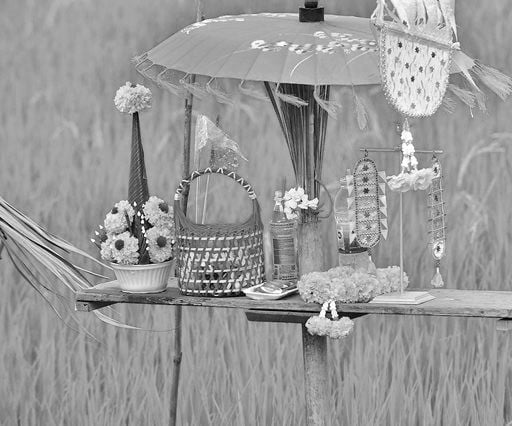
When the rice plants are forming into ears, which the Thais call tang thong (pregnant), the farmers will prepare fruits that pregnant women like to eat, including bananas, tamarinds and sugarcane, to be put in a bamboo basket together with face powder, perfume oil and a comb and placed at an auspicious spot in a field.
Some blades of rice plants are applied with the powder and fragrance and touched with the comb.
These is done as it is believed that at that moment Mae Posop and the rice are becoming pregnant.
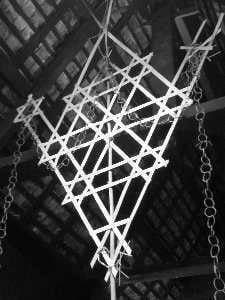
After that a chaleo or talaeo, a multiangular figure made of strips of bamboo, is attached to a stick and planted in the field as a sign indicating that the rice plants are forming ears and that no one should let cows or buffaloes enter the area for they may tread on the plants. The talaeo are ritually put in place as a gesture of respect that stakes a claim of benevolence from the paddy field spirits. Through this propitiation, the field with its crop on the stalks is committed to the tutelage of the rice deity, Mae Posop, and to the protection by the farmers’ patroness, Mae Kasok.
Also, the talaeo is used in other respects of everyday life such as warding off evil spirits or declaring a space off-limits, as well as signaling that the contents of a box, pot, or basket covered with a talaeo are strictly reserved for the owner’s personal use.

When harvest time comes, a reaping bee (long khaek in Thai) will be formed and the group will rotate to help one another until the harvest season ends.
The harvest is combined with a Buddhist ceremony, where farmers invite Buddhist monks to chant, lead a merit-making ceremony, and bless the rice with holy water. The host will invite friends and relatives to join this ceremony. Farmers will tie the stalks of rice, that are considered the rice of Mae Posop, with straw to make a Mae Posop doll. This doll is – sometimes nameless, sometimes known as the “tapuk doll,”– is an essential part of the Rice-Beckoning Ceremony in many regions, when the storage of the rice begins.
Then they will invite Mae Posop to the barn by saying prayers such as the following:
Oh Rice Goddess, come up into the rice bin,
Do not go astray in the meadows and fields
For mice to bite you and birds to take you in their beaks.
Go to the happy place to rear
your children and grandchildren in prosperity.
Come! (“Thailand”)
Sometimes the story of the origin of Mae Posop will be chanted. Or verses of traditional songs, such as this verse:
¨Mae Phosop, Enlightened Goddess of Prosperity, bring back thy glorious blessings into the sanctity of our home, away from the reach of vermin, the heat of fires, to stay in our shelter and raise thy kin.”
Farmers will once again apologize and ask for blessing. After that, they will place the doll in the barn and store the rest of the grains.
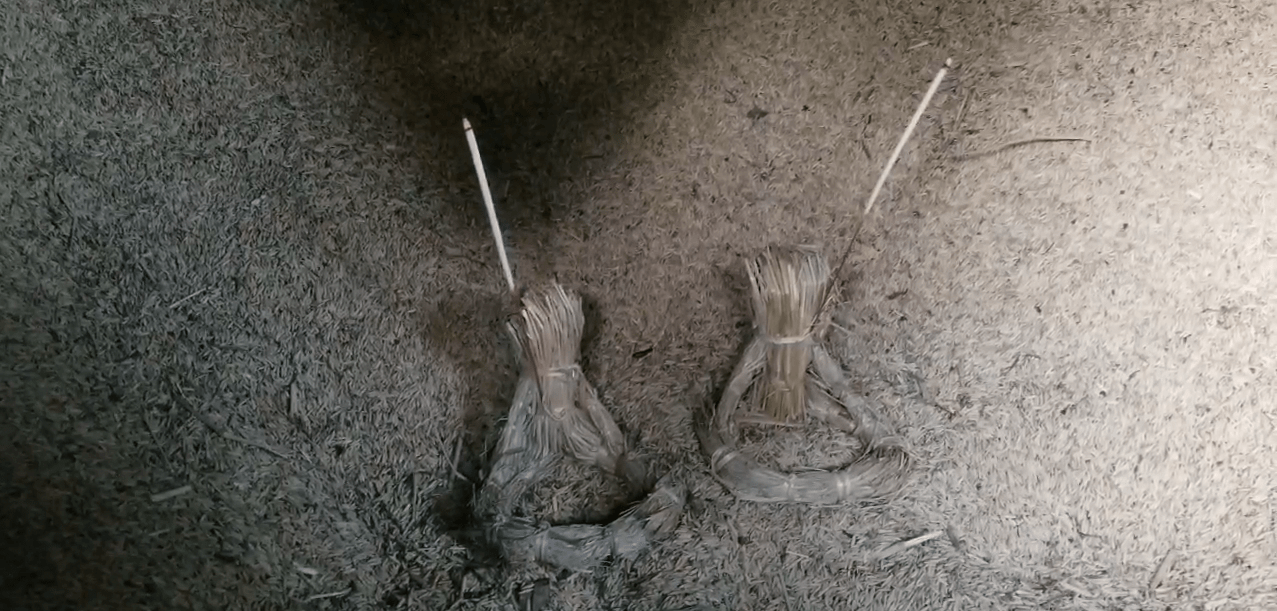
Tapuk Dolls (cr. Komchadluek)
The rice from the doll will be mixed with ordinary rice in the next year’s planting ritual. The barn is a resting place of Mae Posop, so it will be respected and will be opened only when necessary. In some areas, farmers have to light incense to let Mae Posop know that they are going to open the barn and apologize for disturbing her. Harvest is celebrated also with dances as a Thai tradition.
Folk songs
¨Dear Mae Phosop, the enlightened Goddess of Prosperity and Mother of Rice, we beckon thee to descend upon the paddies and accept our offerings of food to appease your appetite for sweet, sour, and savory, for all who live here welcome the Mother. Please eat and bless us with a fine harvest, free from disaster. Please fill our wicker baskets with your rice. Please allow the rice we are growing to blossom like galangals across the paddy fields.”
One can hear farmers sing this verse of the Harvest Song, resonating across the fields as farmers assemble offerings on Friday evening following the end of the Buddhist Lent, which is in October. This time coincides with when the provinces of Central Thailand experience a seasonal flooding of rice paddies. The deposit of silt rejuvenates rice stalks and creates a lush green as new panicles begin to form. As they ripen, the stalks begin to separate and spread outwards in what Thai farmers refer to as hang platoo, literally “mackerel tail.” The Rice-Beckoning Ceremony, known in Thai as Tum Khwan Kaow, commences in many provinces.
While rice is reaping, folk songs are sung to entertain themselves during the work. Mostly, they sing in antiphonal style between a male and a female. And this becomes a recreational folk entertainment. Folk songs can be related to the stages of rice farming, from the beginning of the rice–growing season until after harvest.
When rains of the wet monsoon come, plowing and sowing could get underway, but if the rains were delayed, the farm folk would put a cat in a creel and parade it around the village to ask the gods for rain. This song is sung by a leader who is answered by a chorus, and usually begins with
“Oh Mistress Cat …” and ends with “and the rain comes pouring down, and the rain comes pouring down.”
The lyrics contain coarse language repeated again and again, and when the parade arrives at each house in the village, the owner splashes water on the cat. It is believed that the cat, an animal that hates water, placed in a creel, a basket for aquatic animals, and the coarse language act as a secret method that will induce the gods to send the rain.
There are eight different folk songs for the processes in rice farming and harvesting:
1. Pleng Hae Nang Maeo (parading the cat song)
2. Pleng Kiaw Khao (harvest /cutting rice sheaves song)
3. Pleng Ten Kam (sheaf dance song)
4. Pleng Ten Kam Ram Khiew (sheaf and sickle song)
5. Pleng Song Fang (turning the straw song)
6. Pleng Pan Fang (removing straws song)
7. Pleng Song Kho Lamphuan (sorting out straws song)
8. Pleng Chak Kradan (pulling a board song)
The rice farming calendar
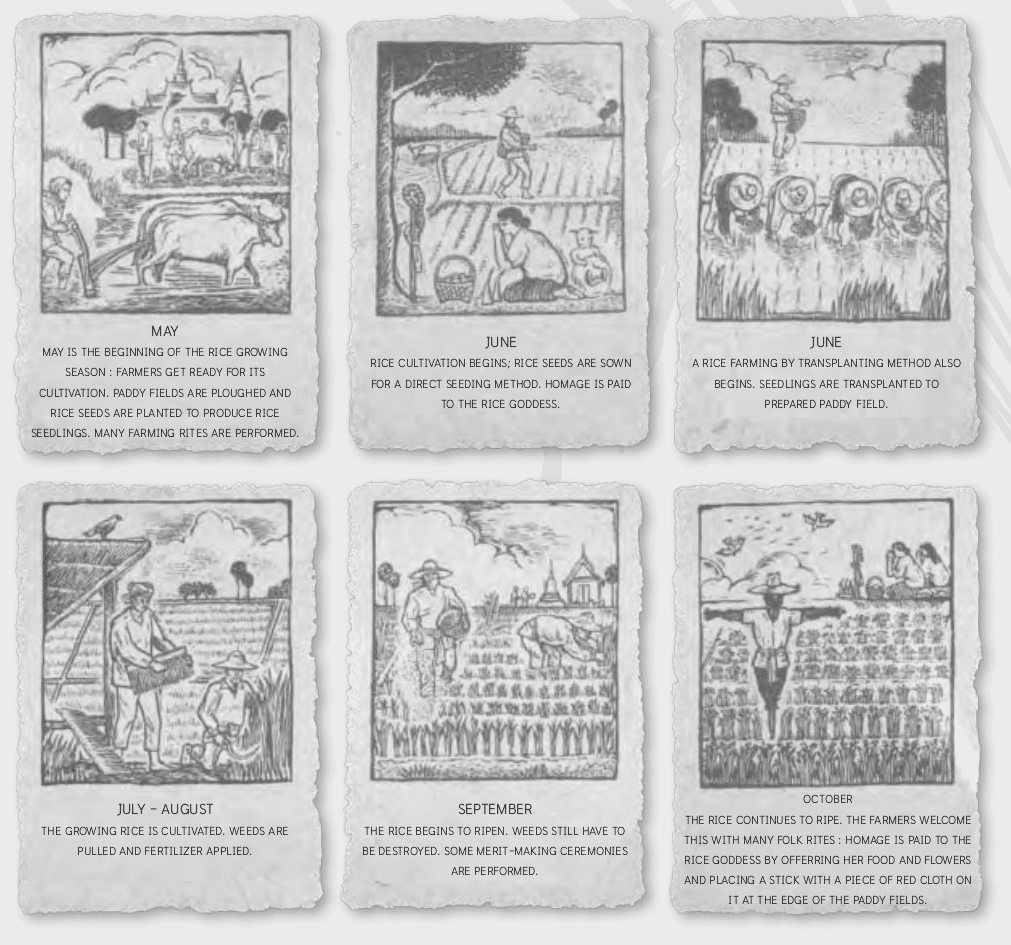
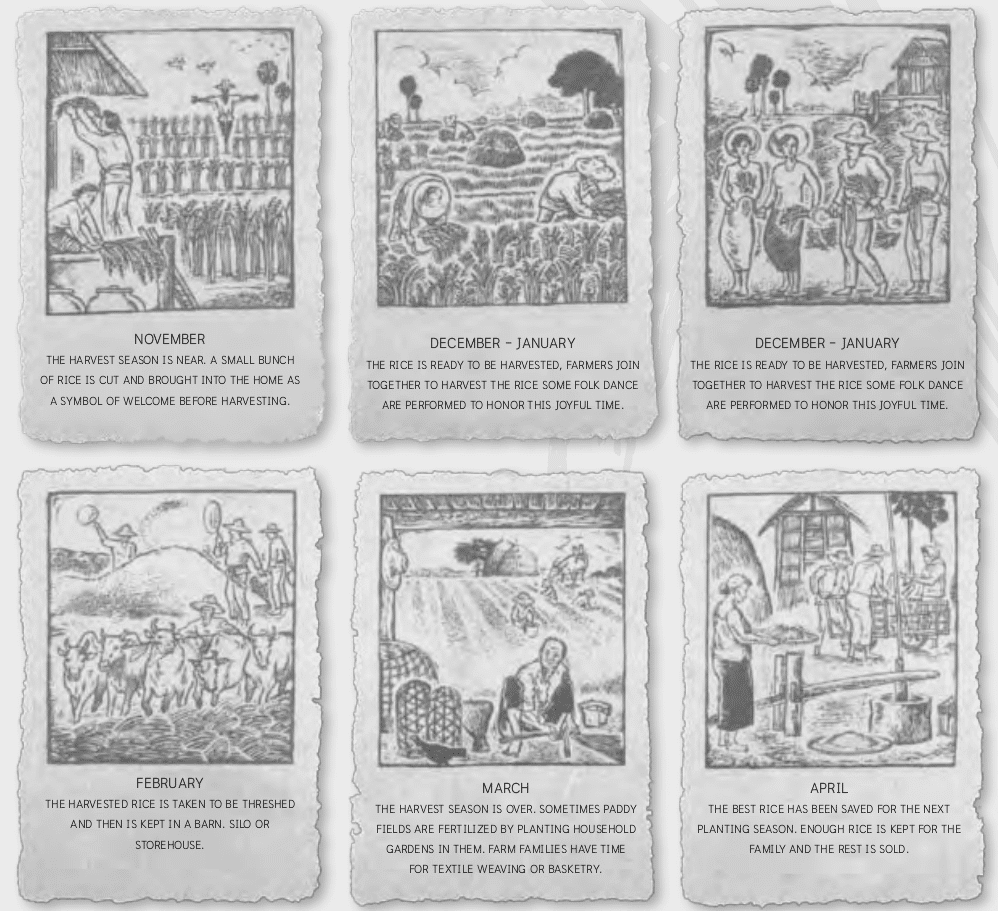
Apart from the ceremonies that the farmers perform which are different from place to place, there is an ancient royal ceremony that has been performed annually in the country at the beginning of the farming season almost uninterruptedly for over 700 years. It is held not only to mark the beginning of the farming season, but also to bless all farmers with fertility for the year.
The royal ploughing ceremony
The influence of rice is not only felt at the level of ordinary citizens. It also prescribe the roles and responsibilities of government leaders including the King and members of the Royal Family. The word ‘king’ in Thai (or Kasat) means the owner and ruler of the land, whose duty is to protect the farmland from dangers and calamities. Thus, an important role of the Thai kings has always been the ‘protector of rice farms,’ so that their subjects can continue to enjoy the fruits of the land and to sustain their lives and well- being from one generation to another.
Originally, this royal ceremony was a Brahman’s ritual done, when the rainy season begins in the sixth lunar month (May) every year.
According to social beliefs, Mother Nature provides fertile land with plenty of water and suitable weather conditions. With the proper plant varieties and the blessing, the people can be happy and contented.
The king presides over the annual Royal Ploughing Ceremony on a regular basis and appoints the Ploughing Lord (Phraya Raekna) to carry out the rites of inaugurating the plough and sow the ritualistic first seeds on Sanam Luang ceremonial ground in his place.
The sacred rice is carried in gold and silver baskets which are carried by consecrated ladies to let the Ploughing Lord to sow the rice seeds onto the ceremonial field and the two sacred oxen pull the plough to cover the grains with earth and thus let it wait for the time when the rain will bring those grains to life.
When the ploughing is finished the oxen are presented with forecast instruments, several foods and drinks
- paddy,
- corn,
- grass,
- nut,
- sesame,
- water and
- alcohol to predict whether the year will be plentiful.
The Royal Ploughing Ceremony is considered the most auspicious for the country’s rice farmers as the crowds are usually seen scrambling for the sacred seeds sown by the Ploughing Lord after the ceremony ends. The seeds are believed to bring the farm owners wealth and good luck.
Moreover, rice is a part of ritual because it is the symbol of richness which is protected by the goddess of rice.
In Thailand, the Royal Plowing Ceremony has been a great event in front of the Grand Palace in Bangkok for more than 700 years. In the ceremony, the Phraya Raek Na (Lord of the Festival) performs a rite to predict the weather during the coming season, plows the field with a pair of ceremonial bulls, and scatters the rice seeds into the field with the help of the four Nang Thepis (consecrated women). People will rush to the field to pick up the sacred rice grain to take home. In the past, the traditional dance Rabam Mae Posop was performed to honor the rice goddess
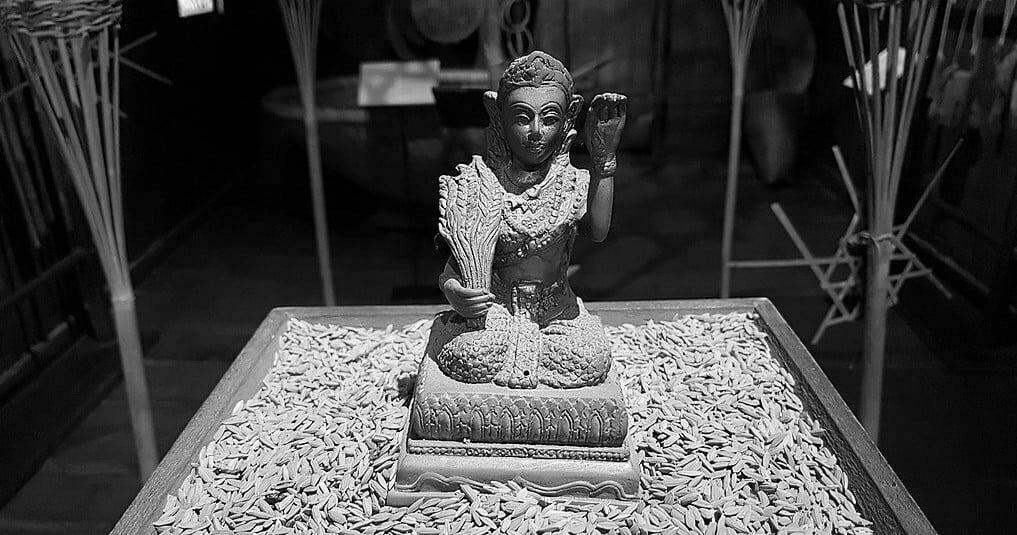
Phosop image on top of rice container. Siam Society Headquarters, Bangkok, Thailand.
Indra sends rice to earth
There is a legend to explain where the rice comes from.
Thai people believe that rice is a holy plant. At first Mae Posop was a plant in heaven. Then Indra, the King of the gods or Devas and Lord of Heaven or Svargaloka in Hindu mythology, (the God of War, Storms, and Rainfall), told her to go to the earth to save people from starvation.
Thai creation myth
Many, many years ago the people of the world grew selfish and wicked. The Gods were angered and sent a great flood to destroy all but three people. Those three survivors were taken to heaven and given the task of being the founders of a new race of people. To help them in their task the Gods created the buffalo and gave this animal to the three ancestors of the Tai. The buffalo would help them to live and survive wherever they went.
The ancestors were then sent back to earth where they used the buffalo to cultivate a field of rice. Once the rice had been harvested the buffalo died. From the body of the buffalo a plant grew. The plant bore fruit that looked like melons. When the fruits ripened they opened and from them emerged the members of a new human race. These new humans were both dark and light skinned.
The Gods taught these people how to grow rice and how to make shelter and Phra Ind, the Hindu God Indra, sent his son, Khun Borom Rachatirath (the name of this myth is “The tale of Khun Borom”) to be their King and teacher. For a quarter of a century he ruled the Tai peoples, he taught them how to worship the Gods and how to take care of the land. He warned them that if they ever forgot these teachings then the floods would return.
Khun Borom had seven sons. At the end of his 25 years he divided the kingdom of the Tai between his sons. They were given the Kingdoms of Ayutthaya, Luang Prabang, Hongsawadi, Sipsong Pan Na, Xiangkhuang (in Laos, it’s where the Plain of Jars is), Northern Vietnam, and Chiang Mai. These kingdoms, or divisions, were called “Muang”, a word that should be well known to those of that live in Thailand.
The rest of the story (of which this is just one variant) deals with the descendants of those Kings and the legendary history of their Kingdoms. I live in Chiang Mai. The name of the son of Khun Borom who was given the Kingdom of Chiang Mai was Khun Saiphong. A descendant of his (9th generation or so) was named Mengrai. King Mengrai is generally acknowledged to be the historical founder of the Tai City State (there was another tribe and city on the site before) of Chiang Mai. At that point we leave myth and enter history.
This is one of the foundation myths of Tai culture. It’s a legendary retelling of the genuine foundation of Tai culture in Southern China and the subsequent migrations of the Tai peoples to the areas they occupy today.
MORE RICE STORIES FROM THAILAND
Yai and the Spirits
In the province of Loei the people tell stories about a great hunter named Yai. They say that Yai was born in the town of Nakorn Chumpasak in Laos, but that Yai moved to Thailand and lived in Loei most of his life. Yai was a great hero and he did many famous deeds. Once he saved a village from spirits, and once he discovered a beautiful and strange mountain.
When Yai moved to Loei he wanted to find a place to be his home. Finally, he came to a small village which is now called Na Pee Ton. Yai gave the village that name, and this is why he chose that name.
One day some of the people in his village came running to Yai. “Help us, help us!” they cried, “our rice crops have been destroyed!”
Yai asked them what was wrong, and they said, “Yesterday when we worked in the fields, our rice was all growing. Today, when we returned to work again, we saw that the best rice had been destroyed. It looked like someone pulled the rice out of the ground. What can we do?”
Yai was very surprised when he heard this story. He did not know what to say. He thought for several minutes, and then he said,
“I do not know what to do, but if someone is destroying the rice, we must find out who that person is. Someone will have to stay in the rice fields all of the time. When he sees the person who comes to destroy the rice, he can return to the village. Then all of us can go out and help catch the bad man.”
Every night several men went out into the fields to watch. But they could not see anything, because there was no moon. And every night more of their rice was destroyed. They were very upset, but Yai said, “You must be patient. Soon there will be a full moon, and then we can see who is doing this to your rice.”
On the night of the full moon every man in the village went to the rice fields. Then they saw something very strange. The rice was being pulled out of the ground, but no one was pulling it. “What is happening?” the people asked.
Yai said, “It must be evil spirits. Wait for a minute, and then we will all shout together. Maybe that will frighten the spirits away.”
When Yai told them they all shouted. Suddenly, the rice stopped being pulled out of the ground. It was very strange, but the spirits had gone away. They did not return. When he was sure the spirits would not return, Yai said, “Let’s call our town ‘Where the Spirits Pulled up the Rice,’” and that is the name of the town until today.
Soft Rice…
Pohnae was a dim-witted man but his wife, Mohnae, was very smart. It was the time of planting but they didn’t have any rice to sow. As was usual in cases like this, Mohnae asked her husband to go and borrow some from a neighbour.
“But only get soft rice” she said, “because it will grow quickly and we can repay the debt sooner”.
Carrying a large jar, Pohnae went from house to house in the village asking to borrow rice. But, everyone he spoke to only had the hard species. He continued his quest without luck until he came to his old friend’s house a few kilometers outside the village centre. Pohnae’s friend was threshing last season’s crop in preparation for new sowing.
“What species is that?” enquired Pohnae.
“Soft” replied his friend.
“May I borrow some?” asked Pohnae.
“Of course” said his friend, “but you’ll have to help me finish the winnowing so we can fill your jar.”
With a jar full of soft rice hoisted on his shoulder, Pohnae set off for home. On the bridge crossing the stream not far from home, Pohnae stumbled, fell and the contents of the jar spilled into the water. He looked in dismay and then he saw that some grains were rising and floating on the surface. Quickly he scooped as many as he could, put them into the jar and set off, once again for home.
“How can you be sure it’s the soft species of rice?” asked Mohnae peering suspiciously into the jar.
“It’s the soft rice for sure,” said Pohnae and he told her about his accident on the bridge and that he had managed to collect all the grains that floated. “It must be soft,” he said with a knowing grin, “all the hard rice sank!”
Mohnae looked at her husband in astonishment and, shaking her head, muttered under her breath,
“You are probably the silliest man I have ever known. But you have a good heart.”
And with that, she set off to find a more soft rice for the planting.
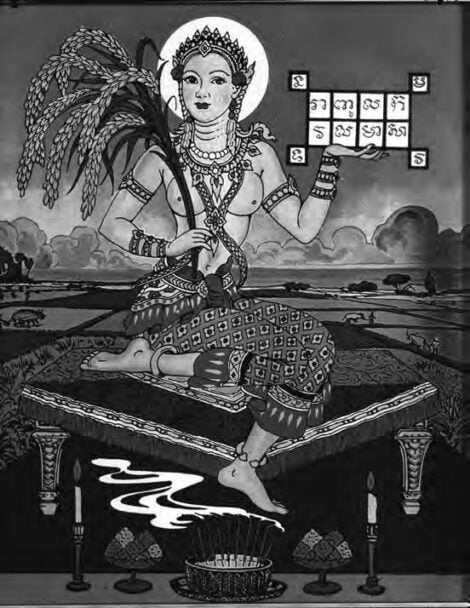
print.
Modern Changes in the Tradition
As technology changes agriculture, creating a system where harvest comes closer to a guarantee, traditions and mythology, such as this varied rice stories and Rice- Ceremonies have changed. The ceremonious aspect of rice farming is no longer as prevalent. Whereas rice could be harvested only once a year, naturally, farmers can now harvest rice up to four times a year now, using the ¨prang farming technique” and irrigation systems
Nevertheless, Mae Phosop is still greatly revered. The Rice-Beckoning Ceremony has also been incorporated into annual temple festivals, more for the sake of performance, mostly to preserve tradition and raise awareness for tourists.
Not only do these demonstrations help preserve tradition, but they also act as a source of hope and motivation for farmers in times of hardship – which, despite technologies being available, surely still exist.
Asia is the most religiously diverse part of the world—Hinduism in India, Buddhism in Thailand, Islam in Indonesia, Roman Catholicism in the Philippines, mixed Taoism and Confucianism in China, Buddhism and Shinto in Japan, and so on. In all of these traditions, we found related ideas about the sacred nature of rice, its divine origin, and its special place in human life. Rice culture clearly predates the religious diversity that later became superimposed across the region.
As technology changes agriculture, creating a system where harvest comes closer to a guarantee, traditions and mythology, such as this varied rice stories and Rice- Ceremonies have changed. The ceremonious aspect of rice farming is no longer as prevalent.
The extents of Myths, History and Folklore of RICE in Asia are hardly to be seized here, there is still much more to discover.
~ ○ ~
Works Cited & Multimedia Sources
- THE MOTHER GODDESS OF FERTILITY AND RICE
- TIMELINE: The story of rice
- MALAYSIA: The Rice Soul- Myths, History and Folklore of RICE Beras or Nasi
- MALAYSIA: Proverbs and wise sayings in relation to RICE Beras or Nasi
- CHINA: On the origin of Rice 稻 – Myths, History and Folklore
- CHINA: Proverbs and wise sayings in relation to RICE 稻
- THAILAND: Proverbs and wise sayings in relation to RICE K̄ĥāw
- INDIA: Proverbs and wise sayings in relation to RICE Chaaval
- INDIA: Myths, History and Folklore of RICE
- INDIA: RICE dishes Khichri, Byriani, Kheer, Dosa &Idlly
- INDONESIA: Myths, History and Folklore of RICE Nasi
- BALI- INDONESIA: Myths, History and Folklore of RICE Nasi
- INDIA: FOLK TALES ON RICE
- CHINA : FOLK TALES ON RICE 稻
- INDONESIA: FOLK TALES ON RICE
- Sujachaya, Sudara, “ [สู่ขวัญข้าวสู่ขวัญชาวนา].” Watthanatham Journal: Department of Cultural Promotion, yr. 51, no. 2, January – March. 2013, pp. 52 – 56. Retrieved April 1, 2021. Link:
- http://magazine.culture.go.th/2012/2/files/assets/basic-html/index.html#page55
- https://www.thailandfoundation.or.th/culture_heritage/tum-khwan-kaow-the-traditional-rice-beckoning-ceremony-of-thai-farmers/
- Father’s rice. In Honour of His Majesty the King. On the auspicious occasion of the Diamond Jubilee of the King’s Coronation. Ministry of Culture. 2010.
- Isaan folk tales. ─ Issanrecord. https://isaanrecord.com/2016/03/11/special-isaan-folk-stories/
- Jotisakulratana Pairin. Mothers of all peoples: goddesses of Thailand from prehistory until the present. A Dissertation Submitted to the Faculty of the California Institute of Integral Studies. 2012.
- Kwanchai A. Gomez. Rice, the grain of culture. The Siam Society, Bangkok, Thailand. 2001.
- Mae Phosop: Goddess of Rice. http://cad.go.th/cadweb_eng/ewt_dl_link.php?nid=89
- Nawigamune Wanna. The Spiritual Side of Rice: A Survey on Art and Culture Inspired by and Related to Rice in Asia, Focusing on the Central Region of Thailand.
- Phosop. ─ Wikipedia. https://en.wikipedia.org/wiki/Phosop
- Rice as a Superfood. Encyclopedia of Food and Culture. ─ Encyclopedia.com. http://www.encyclopedia.com/food/encyclopedias-almanacs-transcripts-and-maps/rice-superfood
- Ruangthong. Rice and Thai Life. ─ Thaiwaysmagazine. https://web.archive.org/web/20161203075626/http://www.thaiwaysmagazine.com:80/thai_article/2102_rice_and_thai_life/rice_and_thai_life.html
- Southern Thailand folktales. https://www.escati.com/8-southern-thailand-folk-tales/
- Thai folklore. ─ Wikipedia, the free encyclopedia https://en.wikipedia.org/wiki/Thai_folklore
- https://www.proquest.com/openview/ffd6e99c73cbb848a785330a7c201d95/1?pq-origsite=gscholar&cbl=18750 THANK YOU
Keep exploring:

